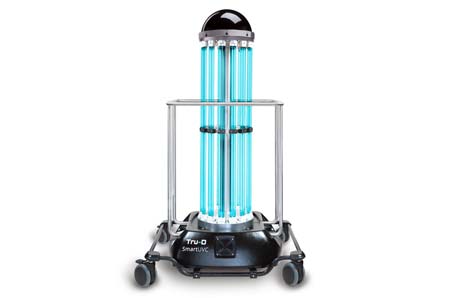The Tru-D® UVC disinfection device has been shown to be effective against Candida auris and Candida albicans in both direct and indirect line of sight, according to a new study, "Inactivation of Candida auris and Candida albicans by ultraviolet-C," in Infection Control and Hospital Epidemiology (ICHE).
The study was conducted at the University of North Carolina Hospital, an acute-care tertiary hospital in Chapel Hill, North Carolina.
The Tru-D device is the only portable UVC system on the market with patented Sensor360® technology, which calculates the precise dose of UVC energy needed to inactivate viruses and pathogens in a room while compensating for room variables such as size, shape, surface reflectivity and contents. The device delivers a measured dose of UVC energy from a single location in the room, eliminating lingering pathogens in the space. In this study, the Tru-D device was set on the vegetative bacterial cycles varying from 17-19 minutes.
"This study shows the Tru-D device's ability to inactivate both C. auris and C. albicans with significant log10 reductions in both direct line of sight and indirect (shadowed) areas," Alice Brewer, MPH, CIC, CPHQ, FAPIC, director of clinical affairs for Tru-D SmartUVC, said. "Due to the unique ability of the Tru-D device to measure the amount of UVC delivered, the robot was able to achieve these high log10 reductions. Devices that have set cycle times may not emit enough energy in the room to achieve these results."
Candida auris is an emerging fungal pathogen that is often resistant to antifungal drugs. It is a serious global health threat and has caused severe infections with frequent mortality in many countries. Candida auris can survive on health care environmental services for at least seven days. Candida albicans is a species of yeast—a single-celled fungus—that is a normal part of the microbes that live in the gastrointestinal tract. However, various factors can throw off the microbial balance in favor of C. albicans, allowing the fungus to grow out of control and cause a yeast infection called candidiasis.
"This study is another testament to the efficacy of our device as well as furthers Tru-D SmartUVC's mission to ensure the cleanest health care environments for both patients and staff," Chuck Dunn, president of Tru-D SmartUVC, said. "While manual cleaning remains a critical part of disinfection, this study echoes the findings from many other studies that a layered approach that includes enhanced disinfection protocols is important for a comprehensive infection prevention program."
The Tru-D robot is one way in which hospitals and health care facilities are elevating the level of care they provide to all patients. Adding Tru-D's enhanced UVC disinfection technology to existing hospital cleaning protocols has been shown to provide a cleaner hospital environment for patients.
For more information, visit www.Tru-D.com.
About PDI:
At PDI, we never forget who we are all working for. That's why we offer a broad range of evidence-based, market leading Interventional Care, Environment of Care, and Patient Care solutions, all designed to help reduce preventable infections, control healthcare costs, and ultimately help save lives. It's all part of our passion to Be The Difference®, every day. For more information, visit www.pdihc.com.

